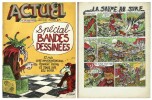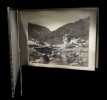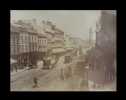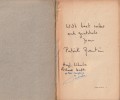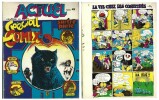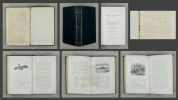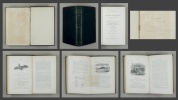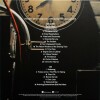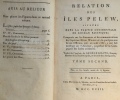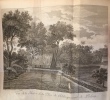2040 books for « wilson »Edit
-
Type
Book (2021)
Disk (2)
Magazine (1)
Music sheets (13)
New book (3)
-
Latest
Last 24h (34)
Last month (20)
Last week (2)
-
Language
Dutch (1)
English (24)
French (2008)
German (1)
Italian (1)
Russian (4)
Spanish (1)
-
Century
18th (12)
19th (50)
20th (1044)
21st (271)
lrb.search.century.FOURTEEN (1)
-
Countries
Belgium (109)
Brazil (2)
Canada (19)
China (2)
Côte d'Ivoire (3)
Denmark (21)
France (1720)
Germany (2)
Greece (1)
Italy (7)
Spain (2)
Switzerland (139)
United Kingdom (9)
United States of America (4)
-
Syndicate
ALAC (15)
CLAM (8)
CLAQ (10)
ILAB (898)
NVVA (10)
SLACES (10)
SLAM (810)
SNCAO (1)
Topics
- 1900 (5)
- Ampelography - wines (11)
- Anticipation (9)
- Archaeology (12)
- Architecture (21)
- Army (7)
- Belgium (6)
- Biography (11)
- Biology (8)
- Buddhism (7)
- Chemistry (5)
- Children’s books (5)
- Children’s books (29)
- China (7)
- Christianity (4)
- Cinema (9)
- Civilisation (5)
- Collections (7)
- Comic strip (82)
- Cooking (94)
- Crime (5)
- Culinary art (58)
- Detective novels (17)
- Dickens charles (5)
- Drawings (9)
- Drink (16)
- Egypt (8)
- England (18)
- English (59)
- Entomology (10)
- Erotic (8)
- Esotericism (12)
- Ethnology (8)
- Europe (6)
- Fantastic (7)
- Fantasy (9)
- Fine arts (18)
- First edition (21)
- Flora (11)
- Gastronomy (10)
- Geography (12)
- Germanic languages (6)
- Germany (5)
- Goya francisco (7)
- Grey-wilson christopher (5)
- Hackney (14)
- History (67)
- Holland (5)
- Industrial arts & crafts - fine arts (6)
- Joyce james (10)
- Linguistics (5)
- Literature (114)
- Medicine (10)
- Military arts (7)
- Mitchell margaret (17)
- Museums (9)
- Navy (9)
- Pacific (8)
- Painters (4)
- Painting (10)
- Paris (7)
- Philosophy (24)
- Photography (20)
- Physics (15)
- Policy (7)
- Posters (4)
- Psychology (13)
- Quebec (10)
- Regionalism (6)
- Religions (17)
- Religions & spirituality (5)
- Review (5)
- Reviews (10)
- Robin (6)
- Romance (7)
- Science fiction (30)
- Sciences (14)
- Sciences & technique (7)
- Scores (18)
- Shroud (5)
- Sociology (5)
- Songs (13)
- Spain (8)
- Spying (5)
- Tea (15)
- Testimonies / stories (6)
- Theatre (11)
- Theology (8)
- Translation (11)
- Travel (9)
- United kingdom (18)
- United states (17)
- Various (18)
- War (29)
- Williams tennessee (9)
- Wilson edmund (20)
- Youth (18)
- Zen (7)
Thunderhawks n° 1 : Les rangers du ciel. ( Avec magnifique dessin original de Colin Wilson et dédicace en anglais ).
Editions Soleil 1992. In-4 cartonnage éditeur.Couverture & dessin de Colin Wilson sur scénario de François Corteggiani. Coins tassés, avec coin & tranche inférieur du 1er plat frottés. Accroc au mors du 4ème plat. Bel état général. Edition originale. Rare exemplaire orné d'un magnifique dessin original de Colin Wilson avec dédicace en anglais.
Site Internet : Http://librairie-victor-sevilla.fr.Vente exclusivement par correspondance. Le libraire ne reçoit, exceptionnellement que sur rendez-vous. Il est préférable de téléphoner avant tout déplacement.Forfait de port pour un livre 7 €, sauf si épaisseur supérieure à 3 cm ou valeur supérieure ou égale à 100 €, dans ce cas expédition obligatoire au tarif Colissimo en vigueur. A partir de 2 livres envoi en colissimo obligatoire. Port à la charge de l'acheteur pour le reste du monde.Les Chèques ne sont plus acceptés.Pour destinations extra-planétaire s'adresser à la NASA.Membre du Syndicat Lusitanien Amateurs Morues
Dans l'Ombre du Soleil, tome 2 : Mantell. ( Tirage de tête, avec sérigraphie, numéroté et dédicacé par Colin Wilson ).
Editions Glénat / Collection " Trait pour Trait " 1986. Enorme in-4 demi-toile à coins, fermé par des languettes en tissu noir, façon carton à dessins, de 58 pages au format 30,5 x 5 x 40 cm. Illustrations en noir aux plats. Préfaces de Geof Darrow et Henri Filippini. Couvertures, pages de garde, croquis, illustrations en noir et scénario de Colin Wilson. Reproduction de deux pages du scénario et découpage. Un des 1500 exemplaires de tête numérotés et signés par l'auteur ( n° 841 ), sur la magnifique sérigraphie en couleurs, située en frontispice. Rare édition originale en superbe état général.
Site Internet : Http://librairie-victor-sevilla.fr.Vente exclusivement par correspondance. Le libraire ne reçoit, exceptionnellement que sur rendez-vous. Il est préférable de téléphoner avant tout déplacement.Forfait de port pour un livre 7 €, sauf si épaisseur supérieure à 3 cm ou valeur supérieure ou égale à 100 €, dans ce cas expédition obligatoire au tarif Colissimo en vigueur. A partir de 2 livres envoi en colissimo obligatoire. Port à la charge de l'acheteur pour le reste du monde.Les Chèques ne sont plus acceptés.Pour destinations extra-planétaire s'adresser à la NASA.Membre du Syndicat Lusitanien Amateurs Morues
( Bandes Dessinées - Revues ) - The Who - Francis Masse - Marcel Gotlib - Richard Corben - Robert Crumb - Clay Wilson - Ronald Laing - Collectif.
Reference : 31350
Actuel n° 40 n° Spécial Bande dessinée - Conversation avec Ronald Laing - Tout sur les Who.
Actuel n° 40 de mars 1974. In-8 agrafé de 96 pages au format 27 x 21 cm. Belles couvertures illustrées par Francis Masse et Clay Wilson. Plats et intérieur frais malgré d'infimes frottis aux coins. Rare numéro spécial, entiérement consacré à la bande desssinée, avec BD de Richard Corben, Francis Masse, Robert Crumb et illustrations de Clay Wilson, Marcel Gotlib. Interview inédite de Ronald Laing. Long article consacré au groupe de Rock " Who ". Nombreuses participations et articles avec illustrations et photographies. Bel état général. Rare édition originale.
Site Internet : Http://librairie-victor-sevilla.fr.Vente exclusivement par correspondance. Le libraire ne reçoit, exceptionnellement que sur rendez-vous. Il est préférable de téléphoner avant tout déplacement.Forfait de port pour un livre 7 €, sauf si épaisseur supérieure à 3 cm ou valeur supérieure ou égale à 100 €, dans ce cas expédition obligatoire au tarif Colissimo en vigueur. A partir de 2 livres envoi en colissimo obligatoire. Port à la charge de l'acheteur pour le reste du monde.Les Chèques ne sont plus acceptés.Pour destinations extra-planétaire s'adresser à la NASA.Membre du Syndicat Lusitanien Amateurs Morues
RancillacRétrospective1962-2002
Musées de Dole et de Saint-Etienne, 2003. In-4, broché sous couverture illustrée en couleur, 152 pp. Avant-propos, par Jacques Beauffet, Sophie Cazé et Anne Dary - Cocktail Rancillac, par Sarah Wilson -Œuvres - Dates - Expositions et Bibliographie - Liste desœuvres exposées.
Illustrations en noir in texte et nombreuses planches couleur.Edition bilingue français/anglais.On joint l'article d'Harry Bellet sur Jacques Rancillac publié dans Le Monde [07/08/2003] à l'occasion de l'exposition de Saint-Etienne. --- Plus d'informations sur le site archivesdunord.com
Phone number : 01 42 73 13 41
Album photographique recelant 50 tirages sur papier albuminé.
Un album au format in-4 à l'italienne (378 x 282 mm). Reliure de l'époque de plein chagrin maroquiné et glacé ébène, double filet gras et maigre doré encadrant les plats ; en outre agrémentés d'entrelacs de filets gras à froid formant moucharabieh, chiffre doré au centre du premier plat, dos lisse orné de doubles filets gras et maigres dorés, tranches dorées, dentelle intérieure dorée.
Recueil comportant 50 clichés tirés sur papier albuminé (réalisés circa 1880) de formats divers (992 x 245 à 147 x 108 mm). Quelques photographies sont légendées dans la plaque et signées GWW (George Washington Wilson), WL ou JV (James Valentine). ''Photographe britannique, George W. Wilson est un des pionniers de la production en grande série de vues pour voyageurs pendant la période de croissance rapide du tourisme en Ecosse dans la seconde moitié du XIXème siècle''. (in Herschdorfer). L'ensemble figure des vues de chemins forestiers, ports, rivières, villages, paysages, scènes de genre animées (charrettes, train), falaises, ruines, cascades, édifices religieux et civils, etc. Légendes : Loch Katrine & Ben Venue - Camstradoan Bay - Loch Lomond - StronachLachar - The Trosachs - Wemyss Castle - Highland - Inversnaid falls - Nearth Abbaye - Melincourt Wales - Dunoon - Crawfordsburn - High Street / Belfast - Antrim Coast road - Red Bay Arch - Portnoon Cave - Dunluge castle. Herschdorfer, Le Dictionnaire de la photographie, p. 416. Reliure présentant quelques frottements. Jaunissement en marge de quelques clichés. L'un est constellé de rousseurs en sa partie supérieure. Ensemble cependant en belle condition.
Boris TaslitzkyBuchenwald :l'arme du dessin
Musée d'art et d'histoire du Judaïsme, Paris, 2006. In-8, broché sous couverture illustrée, 56 pp. Derrière ses yeux pourtant, par Nathalie Hazan-Brunet - Dessins réalisés à Buchenwald, 1944-1945 - Boris Taslitzky : Dessins de Buchenwald (1944-1945), par Guy Krivopissko - Peindre la vérité : la mémoire longue, la mémoire courte, par Sarah Wilson - Biographie ...
Illustrations et planches en noir. --- Plus d'informations sur le site archivesdunord.com
Phone number : 01 42 73 13 41
Richard Wilson Webb et Hugh Callingham Wheeler sous le pseudonyme de Patrick Quentin - Maurice-Bernard Endrèbe.
Reference : 1772
(1949)
Un Mystère de Peter Duluth : Puzzle de Mort. ( Avec jaquette et dédicaces autographes signées des auteurs, Richard Wilson Webb et Hugh Callingham Wheeler et du traducteur, Maurice-Bernard Endrèbe ).
Editions Presses de la Cité / Collection Cosmopolis ( ancêtre de la collection " Un Mystère " ) 1949. In-12 broché de 250 pages au format 12 x 19 cm. Couverture avec titre imprimé. Dos carré. Plats et intérieur parfaits. Exemplaire non coupé. Complet de la belle jaquette illustrée. Rarissime édition originale surtout dans un tél état de fraicheur. Précieux exemplaire orné de 3 dédicaces autographes signées, non nominatives, de Patrick Quentin alias, Richard Wilson Webb et Hugh Callingham Wheeler et du traducteur, Maurice-Bernard Endrèbe.
. Site Internet : Http://librairie-victor-sevilla.fr.Vente exclusivement par correspondance. Le libraire ne reçoit, exceptionnellement que sur rendez-vous. Il est préférable de téléphoner avant tout déplacement.Forfait de port pour un livre 7 €, sauf si épaisseur supérieure à 3 cm ou valeur supérieure ou égale à 100 €, dans ce cas expédition obligatoire au tarif Colissimo en vigueur. A partir de 2 livres envoi en colissimo obligatoire. Port à la charge de l'acheteur pour le reste du monde.Les Chèques ne sont plus acceptés.Pour destinations extra-planétaire s'adresser à la NASA.Membre du Syndicat Lusitanien Amateurs Morues
( Bandes Dessinées - Revues ) - Richard Corben - Robert Crumb - Gilbert Shelton - Nicolas Devil - Clay Wilson - Jean-Paul Sartre - Captain Beefheart - Collectif.
Reference : 31349
Actuel n° 28 n° Spécial Comix - Sartre parle.
Actuel n° 28 de février 1973. In-8 agrafé de 96 pages au format 27 x 21 cm. Belles couvertures illustrées par Robert Crumb et Richard Corben. Plats et intérieur frais . Rare numéro spécial, entiérement consacré au Comix, avec BD de Richard Corben, Robert Crumb, Gilbert Shelton, Nicolas Devil, Clay Wilson, etc. Interview inédite de Jean-Paul Sartre. Nouvelles et textes inédits sur Captain Beefheart, l'Underground, etc. Nombreuses participations et articles avec illustrations et photographies. Bel état général. Rare édition originale.
Site Internet : Http://librairie-victor-sevilla.fr.Vente exclusivement par correspondance. Le libraire ne reçoit, exceptionnellement que sur rendez-vous. Il est préférable de téléphoner avant tout déplacement.Forfait de port pour un livre 7 €, sauf si épaisseur supérieure à 3 cm ou valeur supérieure ou égale à 100 €, dans ce cas expédition obligatoire au tarif Colissimo en vigueur. A partir de 2 livres envoi en colissimo obligatoire. Port à la charge de l'acheteur pour le reste du monde.Les Chèques ne sont plus acceptés.Pour destinations extra-planétaire s'adresser à la NASA.Membre du Syndicat Lusitanien Amateurs Morues
( Bandes Dessinées en Petits Formats ) - Chris Claremont - John Byrne - Gerry Conway - Sal Buscema - Bill Mantlo - Ron Wilson.
Reference : 3596
(1971)
Spécial Strange n° 17.
Editions Lug. Spécial Strange n° 17 du 10 août 1979. In-8 broché de 80 pages au format 24 x 17 cm. Belle couverture illustrée. Dos carré. Plats et intérieur frais. Contient les séries : Les X-Men, Spider-Man et la chose. Scénarios de Chris Claremont, Gerry Conway et Bill Mantlo avec dessins en couleurs par John Byrne, Sal Buscema et Ron Wilson. Rare édition originale, en superbe état général de fraicheur.
Site Internet : Http://librairie-victor-sevilla.fr.Vente exclusivement par correspondance. Le libraire ne reçoit, exceptionnellement que sur rendez-vous. Il est préférable de téléphoner avant tout déplacement.Forfait de port pour un livre 7 €, sauf si épaisseur supérieure à 3 cm ou valeur supérieure ou égale à 100 €, dans ce cas expédition obligatoire au tarif Colissimo en vigueur. A partir de 2 livres envoi en colissimo obligatoire. Port à la charge de l'acheteur pour le reste du monde.Les Chèques ne sont plus acceptés.Pour destinations extra-planétaire s'adresser à la NASA.Membre du Syndicat Lusitanien Amateurs Morues
Howard Philip Lovecraft - L.Sprague de Camp - Colin Wilson - Joseph Altairac - Collectif.
Reference : 13458
(1996)
Le Necronomicon " Le livre de l'Arabe Dément Abdul Al-Hazred " - Précédé de Histoire du Necronomicon par Howard Philip Lovecraft.
Editions Belfond 1989. In-8 broché de 226 pages au format 22,5 x 14 cm. Couverture illustrée. Dos carré. Plats et intérieur frais. Préface de Paul R.Michaud et Colin Wilson. Postface de Joseph Altairac. Textes de Howard Philip Lovecraft, L.Sprague de Camp, Robert Turner, David Langford, Angela Carter, etc, accompagnés d'Illustrations et documents hors texte. Voilà enfin le livre mythique, soi-disant écrit par l'Arabe dément " Abdul Al-Hazred ", œuvre clé de l'univers Lovecraftien. Réédition, augmentée d'inédits, en superbe état général, proche du neuf.
Site Internet : Http://librairie-victor-sevilla.fr.Vente exclusivement par correspondance. Le libraire ne reçoit, exceptionnellement que sur rendez-vous. Il est préférable de téléphoner avant tout déplacement.Forfait de port pour un livre 7 €, sauf si épaisseur supérieure à 3 cm ou valeur supérieure ou égale à 100 €, dans ce cas expédition obligatoire au tarif Colissimo en vigueur. A partir de 2 livres envoi en colissimo obligatoire. Port à la charge de l'acheteur pour le reste du monde.Les Chèques ne sont plus acceptés.Pour destinations extra-planétaire s'adresser à la NASA.Membre du Syndicat Lusitanien Amateurs Morues
La République hollandaise des Provinces Unies
Hachette, collection "l'univers des connaissances", Paris, 1968. In-12, broché sous couverture illustrée en couleurs, 256 pp. 1. Les origines de la République - 2. Le développement économique et la concurrence - 3. Une société bourgeoise - 4. Hugo Grotius et le droit des gens - 5. Une économie à l'échelle mondiale - 6. L'âge de l'observation ...
Nombreuses illustrations en noir et en couleurs in texte. --- Plus d'informations sur le site archivesdunord.com
Phone number : 01 42 73 13 41
A History of British Quadrupeds including the cetacea. Second edition revised an partly re-written bin the author, assisted by Robert F. Tomes and Edward Richard Alston.
London, John van Voorst 1874. Gross-8°. XVIII, 474 S., 2 n.n. S.Anzeigen. Mit 160 Xylographien im Text. Dunkelgrüner Originalleinwandband.
Überarbeitete Fassung der Ausgabe von 1837. - Wellcome 2, 138 (dort mit 1836 und only part III) des erfolgreichen populären zoologischen Werkes. - Auf dem fliegenden Vorsatz mit dem handschriftlichen Besitzvermerk "Edward A. Wilson. Oct. 1905", auf dem fliegenden Vorsatz, darunter von anderer Hand in Bleistift "Scott's last expedition. This book was taken to the Antarctic by E.A.Wilson 1910 - 1913". Obwohl die Innenfälze des Vorder- und Hinterdeckels angebrochen sind, das obere Kapital leicht angerissen und der Einbandbezug leicht fleckig, scheint mir persönlich der Zustand des Exemplares zu gut erhalten für einen Artefakten der berühmten Geschichte von Scotts 2. Antarktik Expedition, bei der Edward A. Wilson, zusammenn mit Scott und Henry „Birdie" Bowers am 29. März 1912 verstarb. Wilson (1872-1912), Mediziner und Zoologe, war bereits an der Discovery-Expedition von 1901-1904 als wissenschaftlicher Leiter beteiligt. Zurück von der mehrjährigen Reise erholte er sich im Sommer 1905 in Irland von den Strapazen der unzähligen öffentlichen Auftritten, Vorträgen und Einladungen. Dabei kam er in Kontakt mit dem Naturalisten Barrett-Hamiltonn der ihn als Illustrator für eine neue Monografie der " A History of British Mammals" engagierte. Wilson lebte im Herbst 1905 in Bushey, einem Künstlerort in der Nähe von London. Obwohl er keine akademische Kunstausbildung besass, wurden seine zoologischen Illustrationen zu Standards der Naturgeschichte Grossbritanniens. Über den Verbleib seiner Bibliothek scheint nichts bekannt zu sein. - Revised version of the 1837 edition - Wellcome 2, 138 (there with 1836 and only part III) of the successful popular zoological work. - With the handwritten ownership note 'Edward A. Wilson. Oct. 1905', on the flyleaf, underneath in another hand in pencil 'Scott's last expedition. This book was taken to the Antarctic by E.A.Wilson 1910 - 1913'. Although the inner folds of the front and back cover are cracked, the upper capital slightly torn and the cover slightly stained, the condition of the copy seems to me personally too well preserved for an artefact of the famous history of Scott's 2nd Antarctic expedition, during which Edward A. Wilson, together with Scott and Henry 'Birdie' Bowers, died on 29 March 1912. Wilson (1872-1912), a physician and zoologist, had already been involved in the Discovery Expedition of 1901-1904 as scientific director. After travelling for several years, he returned to Ireland in the summer of 1905 to recover from the strain of countless public appearances, lectures and invitations. He came into contact with the naturalist Barrett-Hamiltonn, who engaged him as an illustrator for a new monograph of 'A History of British Mammals'. In the autumn of 1905, Wilson was living in Bushey, an artists' village near London. Although he had no academic art training, his zoological illustrations became standards in the natural history of Great Britain. Nothing seems to be known about the whereabouts of his library.
"WILSON, C.T.R. - THE MOST ORIGINAL AND WONDERFUL INSTRUMENT IN SCIENTIFIC HISTORY - WILSON'S CLOUD CHAMBER.
Reference : 45816
(1913)
Über die Expansionsapparat zur Sichtsbarmachung der Bahnen ionisierender Teilchen in Gasen, und über einige mittels dieses Apparats gewonnene Ergebnisse. Mit 23 Figuren im Text und auf 5 Tafeln. (Eingegangen 6. Oktober 1912). (On an Expansion Apparatu...
Leipzig, S. Hirzel, 1913. 8vo. Orig. printed wrappers, no backstrip. Wrappers loose. In ""Jahrbuch der Radioaktivität und Elektronik"", 10. bd., Heft 1. Pp. 1-138 (entire issue offered). Wilson's paper: pp. 34-54, textillustrations, showing apparatus and 5 photographic plates, showing ionizing by Alpha-, Beta- and Röntgen- radiation).
Together with the English version - published 1912 in the Proceedings of the Royal Society - this is Wilson's main paper relating ""that the track of an ionizing particle might be made visible and photographed by condensing water of the ions which is liberated"". The first trails were obtained in 1911 where he submitted a short note of this to the Proceedings. In the offered paper he published the first tracks made by the ionizing particles of alpha, beta and Röntgen-rays. This, Wilson Cloud-Chamber, became an extremely valuable instrument of fundamental research, the discovery of the positron in 1932 and the kaon in 1963 were made by using cloud chambers as detectors.""But the whole course of the particle appears infinitely more clearly by the method invented by C.T.R. Wilson in 1911 and named after him. The radiation is allowed to enter an expansion-chamber, containing a gas saturated with water vapour. A sudden expansion of the chamber cools the gas, and cloud-drops are then formed instantly around the ions produced along the tracks of the particles. By suitable illumination these tracks can be made to stand out clearly as if they had been described by luminous projectiles. The ""Altmeister"" of modern nuclear physics, Lord Rutherford, once called the Wilson chamber ""the most original and wonderful instrument in scientific history"".""Thomson Rees Wilson (1869-1959), a Scottish physicist, is credited with inventing the cloud chamber. Inspired by sightings of the Brocken spectre while working on the summit of Ben Nevis in 1894, he began to develop expansion chambers for studying cloud formation and optical phenomena in moist air. Very rapidly he discovered that ions could act as centers for water droplet formation in such chambers. He pursued the application of this discovery and perfected the first cloud chamber in 1911. In Wilson's original chamber the air inside the sealed device was saturated with water vapor, then a diaphragm is used to expand the air inside the chamber (adiabatic expansion). This cools the air and water vapor starts to condense. When an ionizing particle passes through the chamber, water vapor condenses on the resulting ions and the trail of the particle is visible in the vapor cloud. Wilson, along with Arthur Compton, received the Nobel Prize in Physics in 1927 for his work on the cloud chamber. (Wikipedia).
"WILSON, C.T.R. - THE ""WILSON-CLOUD-CHAMBER"" BROUGHT TO PERFECTION.
Reference : 47063
(1923)
Investigations on X-Rays and Beta-Rays by the Cloud Method.. Part I. - X-Rays. Part II. - Beta-Rays. (2 Papers).
London, Harrison and Sons, 1923. Royal8vo. Contemp. full cloth, gilt lettering to spine. A small stamp to verso of titlepage and on foot of a few leaves.. In: ""Proceedings of the Royal Society"", Series A, Vol. 104. VI,(6),676,XXXII pp., textillustr. and plates. (Entire volume offered). Wilson's papers: pp. (1-) 24 and 12 plates + pp. 192-212 and 9 plates.
First printing of the paper in which Wilson had brought his Cloud Chamber to perfection and showed the photographic tracks of the particles. The Cloud Chamber was the first detector of radioacticity and nuclear transmutations and it played an importent role in experimental particle physics e.g. the discovery of the positron. Wilson received the Nobel prize - together with Arthur Compton - in physics in 1927 for his work on the Cloud Chamber.""The 21 cloud chamber pictures of X-rays and beta-rays on coated stock printed recto only were the culmination of many years research by Wilson and at last showed the full potential of this method as a tool for particle physicists. Early in 1911 (Wilson) was the first person to see and photograph the tracks of individual alpha-particles and electrons. The event aroused great interest as the paths of the alpha-particle were just as W.H. Bragg had drawn them in publication some years earlier. But it was not until 1923 (the paperoffered) that the clous chamber was brought to perfection and led to his two, beautifully illustrated classic papers on the track of electron."" (The Nobel Foundation).
Fifty early american towns
Sous jaquette d'éditeur. Cartonnage d'éditeur crème. Dos lisse avec titre, mentions d'auteur et d'éditeur noir. Fines salissures sur le premier plat. Ex-libris manuscrit sur la page de garde. Bel état du contenu orné de photographies en noir et blanc in-texte.
New-York. Barnes & Co. 1966. 353 pp. In-8 (grand). Cartonné. Très bon état. 1 volume. Publication exclusivement anglophone.
Studies in north american peronosporales — V. A Review of the genus phytophthora, pagination 54 à 83.
S.l., s.e., s.d. (vers 1910) ; 156 x 232 mm, 32 pp., couverture et cahier agrafés (quelques rousseurs en première page). Tiré à part, en langue anglaise. Mycologia (Reprinted from) Vol. VI, No. 2, March 1914. Bon état.
The identity of mucor mucedo, pagination 557 à 560.
S.l., s.e., s.d. (vers 1910) ; 154 x 234 mm, 4 pp., double-feuille. Tiré à part, en langue anglaise. Bulletin of the Torrey Botanical Club (Reprinted from the) 33, 1906. Bon état.
Mycological notes rom indiana — I. Peronospora floerkeae kellerm, pagine 191 à 192.
S.l., s.e., s.d. (vers 1910) ; 151 x 235 mm, 4 pp., double-feuille. Tiré à part, en langue anglaise. Torreya (Reprinted from) Vol. 6, No. 9, September, 1906. Bon état.
Porcupine Tree : Octane Twisted. 2 CD + DVD live.
Japon / Disques WHD Entertainment, Inc. – IECP-20230/231 de 2014. Double CD en importation Japonaise. Version paper sleeve, vinyle réplica, manque le OBI. Comme neuf, bien complet du rare DVD-Video en slipcase cristal,avec fente et petit manque au bas du boitier. Superbe état, proche du neuf. Peu courant complet.
Site Internet : Http://librairie-victor-sevilla.fr.Vente exclusivement par correspondance. Le libraire ne reçoit, exceptionnellement que sur rendez-vous. Il est préférable de téléphoner avant tout déplacement.Forfait de port pour un livre 7 €, sauf si épaisseur supérieure à 3 cm ou valeur supérieure ou égale à 100 €, dans ce cas expédition obligatoire au tarif Colissimo en vigueur. A partir de 2 livres envoi en colissimo obligatoire. Port à la charge de l'acheteur pour le reste du monde.Les Chèques ne sont plus acceptés.Pour destinations extra-planétaire s'adresser à la NASA.Membre du Syndicat Lusitanien Amateurs Morues
( Collection " Un Mystère ", numérotation en chiffres Romains ) - Richard Wilson Webb et Hugh Callingham Wheeler sous le pseudonyme de Patrick Quentin.
Reference : 24514
(1948)
Collection Un Mystère n° II : Puzzle au Mexique ( Puzzle à Mexico ). Une Aventure de Peter Duluth.
Editions Presses de la Cité / Collection " Un Mystère ", numérotation en chiffres Romains n° II de 1948. In-12 broché de 261 pages au format 11,3 x 17 cm. Belle couverture illustrée. Dos resté carré, recollé, avec trace de pliure et petits frottis en haut et en bas. Très légères traces de pliures au coin supérieur droit du 1er plat. Infimes frottis aux coins. Intérieur frais, malgré de presques imperceptibles traces de scotch et de minuscules rousseurs en pages de garde. Rejaquettage de ce roman paru dans collection Cosmopolis, qui suite à l'arrêt de cette dernière, fut intégré à la collection " Un Mystère " dans la série dite des " Chiffres romains" sous le n° IX. Cette tête de série ne comporte que 8 titres dont tous portent l'achevé d'imprimer de l'édition originale. Le numéro VIII, " La Poupée de Cire " par Ngaïo Marsh, n'ayant certainement jamais été publié.
Site Internet : Http://librairie-victor-sevilla.fr.Vente exclusivement par correspondance. Le libraire ne reçoit, exceptionnellement que sur rendez-vous. Il est préférable de téléphoner avant tout déplacement.Forfait de port pour un livre 7 €, sauf si épaisseur supérieure à 3 cm ou valeur supérieure ou égale à 100 €, dans ce cas expédition obligatoire au tarif Colissimo en vigueur. A partir de 2 livres envoi en colissimo obligatoire. Port à la charge de l'acheteur pour le reste du monde.Les Chèques ne sont plus acceptés.Pour destinations extra-planétaire s'adresser à la NASA.Membre du Syndicat Lusitanien Amateurs Morues
- Wilson Brian,Wilson Carl,Wilson Dennis,Jardine Al - Wilson Brian,Jardine Al
Reference : 89324
(1968)
On the Condension Nuclei produced in Gases by the Action of Röntgen Rays, Uranium Rays, Ultra-violet Light, and other Agents. Received October 29, - Read November 24, 1898.
(London, Harrison and Sons, 1899). 4to. No wrappers as extracted from ""Philosophical Transactions"", Vol. 192 - Series A. Pp. 403-453. Textillustrations. Clean and fine.
First printing of Wilson's second importent paper describing his further experiments with his ""Cloud Chamber"".""To the period 1895-1912 belongs the development of an instrument which to my mind is the most original and wonderful in scientific history.I refer to the cloud or expansion chamber of C.T.R. Wilson...It was a wonderful advance to be able to se, so to speak, the details of the adventures of these particles in their flight through the gas....""(Lord Rutherford).""C.T.R. Wilson had been developing his cloud-chamber, which was to provide the most powerfull of all methods of investigation in atomic physics. In moist air, if a certain degree of supersaturation is exceeded this can be secured by a sudden expansion of the air) condensation takes place on dust-nuclei, when any are present: if by preliminary operations condensation is made to take place on the dust-nuclei, and the resulting droplets are allowed to settle, the air in the chamber is thereby freed from dust. If now X-rays or radiation from a radioactive substance are passed into the chamber, and if the degree of supersaturation is sufficient, condensation again takes place: this is due to the production of ions by the radiation. Thus the tracks of ionising radiations can be made visible by the sudden expansion of a moist gas, each ion becoming the centre of a visible globule of water. Wilson showed that the ions produced by uranium radiation were identical with those produced by X-rays."" (Whittaker in ""A History of the Theories of Aether and Electricity."" II, p. 4).
"WILSON, C.T.R. - THE INVENTION OF THE WILSON ""CLOUD CHAMBER""
Reference : 42616
(1897)
Condensation of Water Vapour in the Presence of Dust-free Air and other Gases. Communicated by J.J. Thomson. Received March 15, - Read April 8, 1897.
(London, Harrison and Sons, 1897). 4to. No wrappers as extracted from ""Philosophical Transactions"" Year 1897, Volume 189 - Series A. - Pp. 265-307. Clean fine. Textillustrations, depicting Wilson's famous apparatus
First printing of this groundbreaking paper in which Wilson describes the invention which made it possible to view the track of a single atomic projectile or electron. The invenvention of the ""Dust-Chamber"" made it possible for J.J. Thomson in 1897 to calculate the charge of the electron, and thereby finding its mass, since the ratio between the two was known. In most cases it was found that the track of the particle is a straight, or nearly straight line.""C.T.R. Wilson had been developing his cloud-chamber, which was to provide the most powerfull of all methods of investigation in atomic physics. In moist air, if a certain degree of supersaturation is exceeded this can be secured by a sudden expansion of the air) condensation takes place on dust-nuclei, when any are present: if by preliminary operations condensation is made to take place on the dust-nuclei, and the resulting droplets are allowed to settle, the air in the chamber is thereby freed from dust. If now X-rays or radiation from a radioactive substance are passed into the chamber, and if the degree of supersaturation is sufficient, condensation again takes place: this is due to the production of ions by the radiation. Thus the tracks of ionising radiations can be made visible by the sudden expansion of a moist gas, each ion becoming the centre of a visible globule of water. Wilson showed that the ions produced by uranium radiation were identical with those produced by X-rays."" (Whittaker in ""A History of the Theories of Aether & Electricity"" II:p.4).
The Ephemera of Adrian Wilson : an annotated list, 1944-1988
Tuscany Alley, San Francisco 1994, 27x39cm, 2 volumes reliures en de l'éditeur, sous étui.
Edition originale, un des 75 exemplaires numérotés sur Rives, seul tirage avec 10 également sur Rives signés par Adrian Wilson et 3 hors commerce. Reliures en pleine toile crème, dos lisses, exemplaire bien complet de son étui. Ouvrage illustré de nombreux bois originaux d'Adrian Wilson. Notre exemplaire est bien complet de sa chemise qui renferme une cinquantaine de pièces imprimées représentatives du travail d'imprimeur d' Adrian Wilson. Rare et très bel exemplaire. - Photos sur www.Edition-originale.com -


Phone number : 01 56 08 08 85
Relation des Îles Pelew, situées dans la partie occidentale de l'Océan Pacifique ; composée sur les journaux et les communications du Capitaine Henri Wilson, et de quelques-uns de ses officiers, qui en Août Mil Sept Cent Quatre-Vingt-Trois, y ont fait naufrage sur l'Antelope, Paquebot de la Compagnie des Indes Orientales.
Paris, Maradan, 1793. 1788 2 vol. in-8° (195 x 131 mm) de : I. [2] ff., 280 pp., [1] f.bl. ; II. [2] ff., 272 pp., [2] ff. bl.; 1 portrait frontispice, 1 carte dépliante, 16 planches gravées. Plein maroquin rouge d'époque, dos lisse orné, pièces de titre et de tomaison de maroquin fauve, filet et frises encadrant des plats, roulette dorée sur les coupes, tranches dorées.
Seconde édition française, parue la même année que l'originale anglaise (EO: 1788). En 1783, le capitaine de vaisseau Henry Wilson (décédé en 1810) qui était au service de la compagnie des Indes fait naufrage près de la petite île, appelée Ouroulong, près des Pelew. Ce récit est la relation du séjour prolongé de ce groupe danglais sur les îles Pelew de Mindanao. Ce contact avec les insulaires donne lieu à des descriptions de leur comportement, de leurs murs, de leur mode de vie qui sont du plus haut intérêt. Aba-Thoulé, chef du pays, reçut Wilson avec beaucoup d'humanité, lui donna un petit bâtiment pour rentrer dans sa patrie et lui confia même son fils, Li-Bon pour l'éduquer et introduire dans les moeurs et les arts de l'Europe. Le jeune homme mourut de la petite vérole à la fin de 1784. Un vocabulaire de la langue Pelew occupe les pages 251 à 267. Boucher de la Richarderie est assez sceptique quant au portrait idyllique de ces îles brossé alors par lauteur : "L'existence de ces îles, où Wilson et son équipage ont trouvé un peuple dont les nations les plus civilisées de l'Europe pourraient envier les vertus morales, a paru douteuse à quelques personnes et surtout en France, malgré tous les droits que le rédacteur paraît avoir à la confiance à ses lecteurs. Mais ce doute pourrait bien ne tenir qu'à l'espèce de fatalité qui, depuis la publication en Angleterre du Voyage original, jusqu'à sa traduction en français, semble avoir toujours dérobé l'approche et la connaissance de ces îles aux navigateurs." L'ouvrage est illustré de dix-sept planches : frontispice représentant le capitaine Wilson d'après Russel et gravé par Mme Massard, des cartes, portraits, vues... Bel exemplaire. Cox III, 302-303 - Chadenat 3258: "Relation très recherchée" - Boucher de la Richarderie VI, 552. 2 vol. 8vo. 1 frontipiece portrait, 16 engraved plates. First French edition, published the same year than the London OE, of this classical relation of the shipwreck of Henri Wilson and his crew on Ouroulong, little island nearby the Pelew Islands. They stayed a long time there, long enough to bring back very precious ethnographical informations, and a description of an "idyllic" society, a people "from whom the most civilized European nations should envy their virtue." (Boucher de la Richarderie). Fine copy.


Phone number : 06 81 35 73 35
 Write to the booksellers
Write to the booksellers




